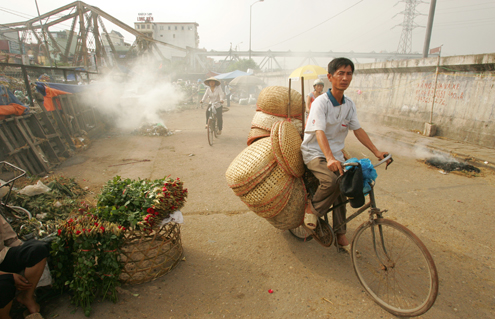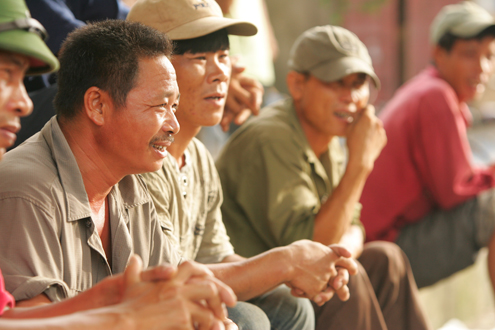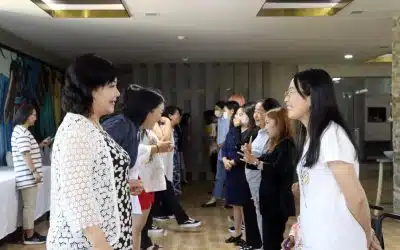InAsia
Insights and Analysis
Vietnam’s Migrant Workers: Greatest Advantage, Greatest Challenge
September 28, 2011
The number of migrants pouring into Vietnam’s cities as the nation rapidly industrializes and modernizes is staggering. The Vietnamese government estimates that in 2009 there were 1.99 million migrants in Ho Chi Minh City, nearly 30 percent of the population.

Although Vietnam’s 26 million migrants have contributed greatly to the nation’s economic growth, they struggle to access services in the large cities where they work.
The majority of migrants are young and, increasingly, women. Migrants represent both Vietnam’s greatest advantages and greatest challenges. Their 14-15-hour work days have helped fuel the economic miracle that has rocketed Vietnam from one of the five poorest countries in the world in 1985 to an average per capita income of over $1,000 in 2010. Economic reform, combined with cheap, flexible labor has led to a surge in foreign investment. Booming consumerism is visible in the adverts on every street corner and the accessories hanging off Vietnam’s newly wealthy youth. A young and vibrant population provides the continued promise of future economic expansion and innovation.
With low incomes, poor benefits, unstable employment, and far from traditional family support systems, migrants are particularly vulnerable – a situation worsened by the global economic crisis. In Ha Noi, the government estimates that only 11 percent of newly resident laborers have work contracts compared with 90 percent of local residents. Ministry of Health statistics show only 30 percent of private companies pay health insurance fees for their workers and 90 percent of new residents from the countryside have no social insurance.
Migrants also struggle to access state support. Their permanent registration documents, or their ho khau, and with it their rights to access government services, remain tied to their homes in the countryside. Historically, the ho khau system was used as part of the public administration system both to control the movement of the population but also to allocate scarce resources and public services during the war years. As Vietnam has opened up since the doi moi reforms in the late 1980s, the system has loosened. Increasing numbers of people have moved away from the places where they are registered. In theory, migrants can get official permission to change their registration. In practice, large numbers of migrants cannot do so, unable to fulfill the conditions required. This state of limbo means even seemingly simple tasks such as registering a birth can become complex and fraught. The expense and bureaucratic convolutions of accessing basic health and education services put them beyond the reach of many.
The immediate challenges of dealing with such a massive population shift are huge. Binh Chieu, like most of the industrial zones that ring Ho Chi Minh City, is dominated by row upon row of anonymous-looking factories churning out textile, footwear, and electrical products for export. The local government there estimates that 65 percent of the population are migrant laborers. The vast majority of migrants arrived over the last decade and have created a huge strain on infrastructure and services. Far from traditional familial restraints and forced to adapt rapidly to an urban lifestyle, migrant communities have increased incidence of social problems such as prostitution, drugs, and HIV/AIDs infection.

Workers wait for day labor job in Ha Noi City. The government estimates that in Ha Noi, only 11 percent of newly residents laborers have work contracts, compared with 90 percent of local residents.
Government approaches to migrant worker issues have often come from the point of view of managing migration flows and social problems rather than supporting a dynamic labor source and providing protection. No one department is responsible for migrant social policy which means that their specific challenges frequently fall between the cracks. Non-governmental support for migrant workers in Vietnam is increasing, but it is often viewed with suspicion both by companies and local governments concerned about potential labor unrest and uncertain about NGOs’ intentions. This resistance can make it very challenging for NGOs to develop projects to support migrant workers. The few NGO programs that do exist are limited in size and scope.
In response, over the last 18 months, with support from The Rockefeller Foundation, The Asia Foundation worked with Vietnamese civil society to build innovative programs to support migrant workers in Ha Noi and Ho Chi Minh City. With our local partner organizations, we have created health and education service models tailored to migrant workers, and helped migrants access information and better understand their rights. We also helped set up a hot line, website, and information center for migrant workers to disseminate information on employment, provide online counseling, and work closely with local authorities to advocate for additional support. Our partners have trained 86 staff members from organizations that provide training and consultation to migrants on life skills, legal education, and workers’ rights. Through this program, we have provided nearly 1,500 migrants with legal counseling and critical information on safe migration, life and work in the cities, HIV/AIDS prevention, reproductive health, legal and labor rights, and employment counseling.
In Ho Chi Minh City last month, The Asia Foundation brought together migrant workers, NGO workers, and officials from the North and South, to share experiences on approaches to supporting migrants and consider how to alleviate the impact the global financial crisis continues to have on these vulnerable population.
Interestingly, the discussions produced some clear contrasts in attitudes between the North and South. The authorities in Ho Chi Minh City stressed the economic benefits of migrant workers, the economic dynamism they provide, and the active steps local authorities are taking to try and address the issues a large migrant worker population presents. They emphasized regulatory changes, allowing migrants to change their registration if they can demonstrate they have been in the city over the year. They discussed successful innovations; multi-stakeholder approaches involving close cooperation between local officials, hostel owners, police and NGOs, engaging with migrant worker groups to breach the gaps between the authorities and migrant communities, and embedding public communications into community events. The NGOs from the South also stressed their close cooperation with the authorities, and the importance of filling gaps in official service delivery. There were also hints of a more entrepreneurial spirit, and excited discussions of how to develop services on the basis of social enterprise models.
The conversation among the northerners was more cautious and focused on the risks presented by migrant workers. Participants talked about the potential that greater social services for migrants could lead to even higher numbers of arrivals. Others talked about the need to tackle many of the migration issues at source. They felt that the authorities in source cities should provide more information and help ensure a more ordered flow of migrants to identified jobs. Northern NGO participants showed a greater interest than their southern counterparts in public advocacy approaches to engage migrant workers in groups to discuss common issues.
The different approaches perhaps reflect the different character of migration in the North and the South. A large proportion of the migrant workers in Ho Chi Minh City’s factories are recruited directly from the provinces for specific jobs. There is a core, relatively more stable population established over a longer period, bringing family, forming communities and, for some, achieving prosperity. Northern authorities on the other hand view many migrants in Ha Noi as having lower levels of education and containing a higher proportion of freelancers who shift frequently between odd jobs, scrapping for opportunities in the informal economy, and thus represent a bigger economic and social challenge.
Whether these North versus South characterizations are accurate or more a matter of perception, what we could all agree on was the magnitude and range of the needs and challenges migrant populations face. It was particularly encouraging to see officials in both Ha Noi and Ho Chi Minh City express their appreciation for the work carried out by the NGOs involved in our project. It is clear that NGO workers and officials in the North and South will benefit from increased engagement with each other, and hopefully learn lessons from each other’s programs. Ultimately, a mix of all these approaches will be needed to support this growing, vulnerable population. Tackling these challenges successfully will be critical to Vietnam’s continued economic growth.
Editor’s note: This post has been edited slightly from the original.
William Taylor is The Asia Foundation’s deputy country representative in Vietnam. The views and opinions expressed here are those of the individual author and not those of The Asia Foundation.
About our blog, InAsia
InAsia is posted and distributed every other Wednesday evening, Pacific Time. If you have any questions, please send an email to [email protected].
Contact
For questions about InAsia, or for our cross-post and re-use policy, please send an email to [email protected].The Asia Foundation
465 California St., 9th Floor
San Francisco, CA 94104
The Latest Across Asia
Program Snapshot
April 18, 2024
News
April 17, 2024

2024 Lotus Leadership Awards
Thursday, April 25, 2024, New York City
The Lotus Leadership Awards recognize contributions towards gender equality in Asia and the Pacific







0 Comments